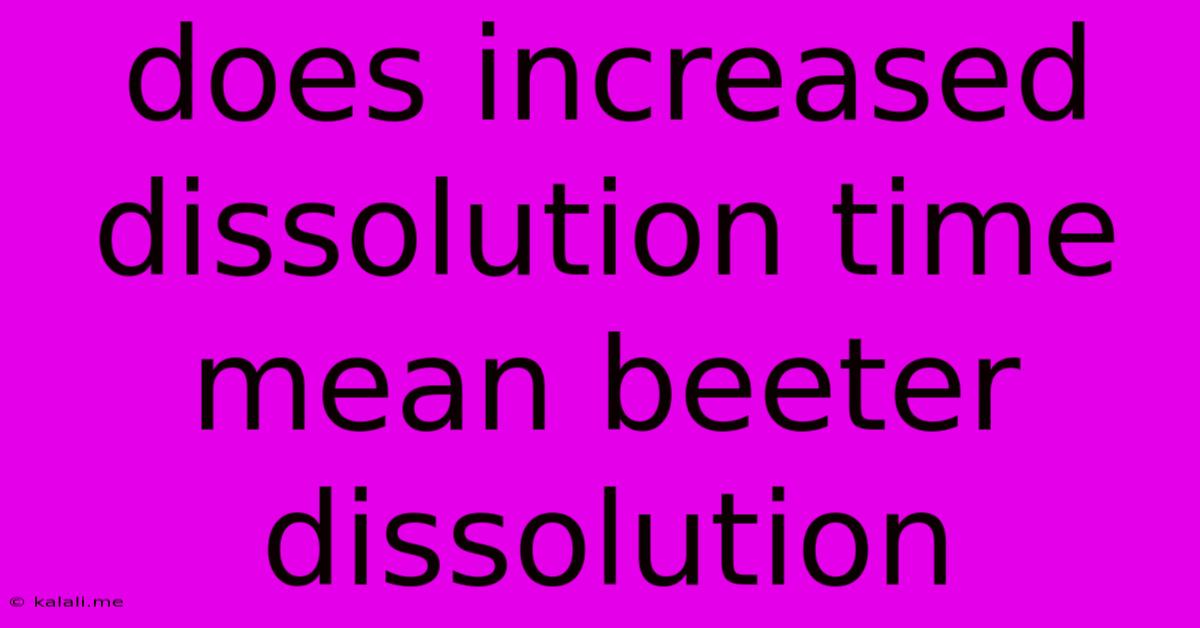Does Increased Dissolution Time Mean Beeter Dissolution
Kalali
May 31, 2025 · 3 min read

Table of Contents
Does Increased Dissolution Time Mean Better Dissolution? A Complex Question
Meta Description: Understanding the relationship between dissolution time and dissolution quality is crucial in drug development. This article explores the complexities, highlighting that longer isn't always better, and explains the factors influencing optimal dissolution profiles.
Dissolution testing is a critical component of pharmaceutical development and quality control. It assesses how quickly and completely a drug substance dissolves in a specific medium, mimicking the conditions in the body. A common misconception is that a longer dissolution time automatically translates to better dissolution. However, the reality is far more nuanced. While sufficient dissolution is essential for bioavailability and therapeutic efficacy, excessively long dissolution times can indicate problems and aren't always desirable.
The Importance of Dissolution Rate
The rate of dissolution, and its resulting profile, is paramount. A drug needs to dissolve at a rate that allows for adequate absorption into the bloodstream to achieve the desired therapeutic effect. Insufficient dissolution leads to poor bioavailability, meaning less of the drug reaches its target site, potentially compromising treatment efficacy. This is particularly important for drugs with narrow therapeutic windows.
Why Longer Isn't Always Better
Several factors influence dissolution, and a prolonged dissolution time may signify underlying issues rather than improved performance:
-
Poor Drug Solubility: A long dissolution time can indicate that the drug substance itself is poorly soluble. This is a fundamental formulation challenge, requiring innovative approaches like using solubilizing agents or modifying the drug's crystalline form (polymorphism). Simply waiting longer won't solve this inherent problem.
-
Formulation Issues: The formulation's physical characteristics play a massive role. Poorly designed formulations might have issues with particle size distribution, leading to uneven dissolution. Agglomeration of particles can also hinder the dissolution process, extending the time required. This points towards reformulation strategies, not just increased time.
-
Insufficient Drug Release: While a long dissolution time might imply complete release, it doesn't guarantee it. The drug might be slowly dissolving, but a significant portion might remain undissolved even after an extended period. This needs to be assessed using other methods.
-
Unnecessary Delay in Onset of Action: For immediate-release formulations, a long dissolution time translates to a delayed onset of action. This is undesirable for situations requiring rapid therapeutic intervention.
Optimal Dissolution Profiles: The Key Consideration
The goal isn't simply maximizing dissolution time; it's achieving an optimal dissolution profile. This profile should ensure rapid and complete dissolution within a clinically relevant timeframe, maximizing bioavailability and therapeutic effect. The optimal timeframe depends entirely on the specific drug, its intended use, and the desired onset and duration of action.
Different drug delivery systems will have different expectations for dissolution profiles. For instance, extended-release formulations are intentionally designed to have prolonged dissolution, providing a sustained release of the drug over time. Conversely, immediate-release formulations require rapid dissolution for immediate action.
Conclusion: A Holistic Approach
In conclusion, longer dissolution times aren't automatically indicative of better dissolution. A comprehensive understanding of the drug's physicochemical properties, formulation design, and the desired therapeutic outcome is crucial. Dissolution testing should be viewed holistically, with the focus shifting from simply measuring time to analyzing the complete dissolution profile and ensuring it aligns with the intended clinical application. The ultimate aim is to achieve efficient and complete drug release, optimizing bioavailability and therapeutic efficacy. This requires a scientific approach to formulation and careful interpretation of dissolution data, rather than simply seeking to extend the dissolution time.
Latest Posts
Latest Posts
-
Postgres Add Column If Not Exists
Jun 01, 2025
-
Mountain Bike Tire Pressure For Road
Jun 01, 2025
-
Canon Ae 1 Film Advance Lever Stuck
Jun 01, 2025
-
Sort Df By Value Of Row
Jun 01, 2025
-
What Is It Called When Someone Says Atm Machine
Jun 01, 2025
Related Post
Thank you for visiting our website which covers about Does Increased Dissolution Time Mean Beeter Dissolution . We hope the information provided has been useful to you. Feel free to contact us if you have any questions or need further assistance. See you next time and don't miss to bookmark.